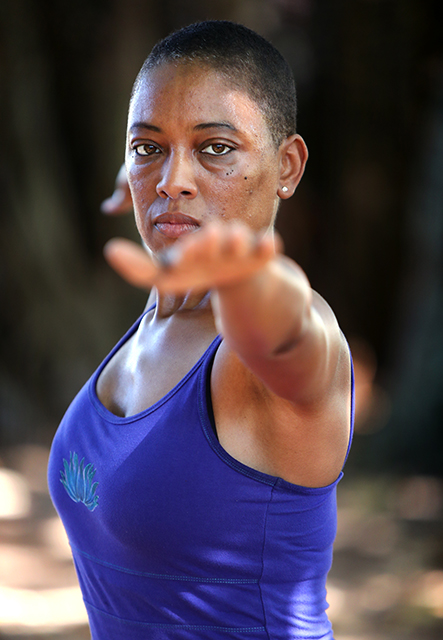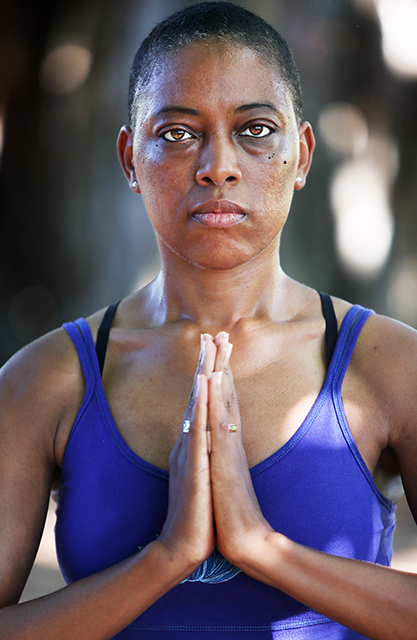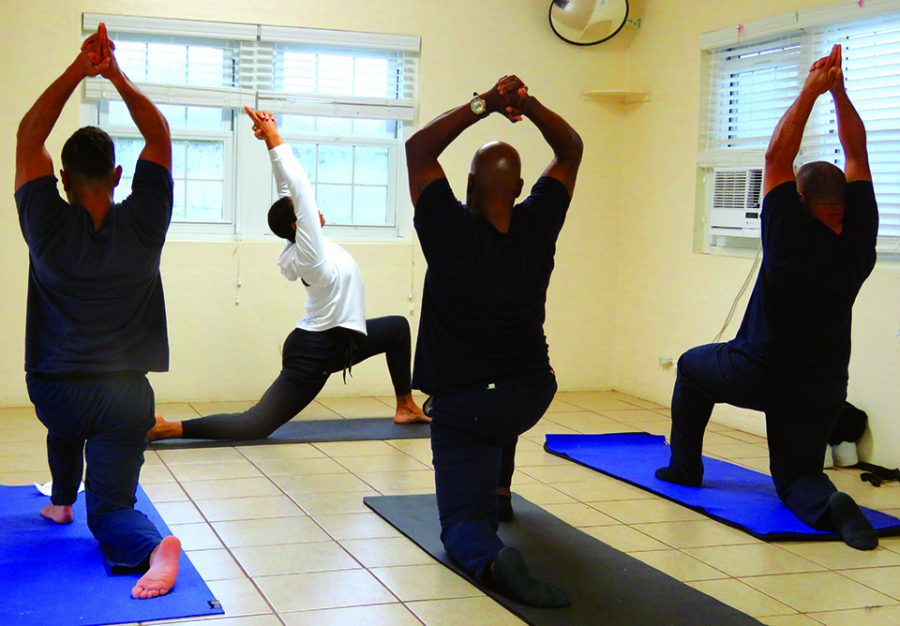Photographs by Blaire Simmons
She agreed to meet at Devil’s Isle. I was unsure of who I was looking for, but a brief conversation on the phone a few days earlier gave me an idea of Shanell Vaughn’s energy. I imagined an aura over the head of the martial artist, yoga specialist, business owner and social entrepreneur behind “Peace Within” — a programme that brings yoga to Bermuda’s prisoners.
She was sitting up against the restaurant’s white drapery, an apt backdrop of serenity. There was no circle of light, but her movements came with that surety and humility that I expected when she got up to say hello, ordered her Classic Harvest Bowl, sipped her water, and talked to a total stranger about her life’s work. Her answers came with a confidence only 15 years of self-reflection could give.
 Shanell’s business, Shambhala (a Tibetan word meaning “a place of peace where enlightened beings dwell”), started in 2014 as a holistic healing practice. Destroyed by the fire at 79 Front Street in 2016, it temporarily lives at The Healing Centre on Euclid Avenue, until she can find somewhere to revive it.
Shanell’s business, Shambhala (a Tibetan word meaning “a place of peace where enlightened beings dwell”), started in 2014 as a holistic healing practice. Destroyed by the fire at 79 Front Street in 2016, it temporarily lives at The Healing Centre on Euclid Avenue, until she can find somewhere to revive it.
In the meantime, Shanell launched a project, working with the seemingly forgotten part of the Bermuda community. “The Peace Within Prison Yoga Programme [started in January 2018] came from a desire to make the yoga that I teach accessible to more people.” With calm excitement, she explained, “One day, I saw a video of yoga classes being held in a penitentiary in Washington State. The idea immediately grabbed me and I wanted to do that in Bermuda. I wanted to reach people who may not, for various reasons, ever step foot in a yoga studio”. So far, that reach has made it to the Prison Farm (men) and the St. George’s Co-Educational Facility (women).
“What is yoga?” A question that all yogis are asked and answer different. Specifically, what was yoga to her that it should live in these places that hardly mattered to anyone? “Yoga is a practice in the art of peace.” She began to explain. “I found in my personal life when I was going through a difficult transition many years ago that yoga had this subtle way of dissolving the walls that I had created around my heart, and introducing me to an inner peace that I hadn’t experienced before. Yoga is a way to calm and purify the mind so that we can bring balance to each level of our existence –– body, mind and spirit. It is the science of self-realisation, meaning that when the mirror of our minds is clear and quiet, it reflects the true peace and joy that is innate in each one of us. In this way, offering yoga to inmates aids in their rehabilitation process by helping them to find a space and peace within themselves to manage their situation, to learn to use breath control to master their minds and overcome negative reactions, and ultimately their improved mental and physical health serves the well-being of the whole community when these individuals are released.”
Many people commonly think of yoga as just a workout, but Shanell has made her offering different. “Yoga is a systematic practice that gives us the skills to go beyond our base emotions rooted in the ego: fear, anger, greed etc., so that we can access our higher emotions rooted in love. We practice on our mats to be with whatever arises physically or mentally, and to be gentle with ourselves.” For the 5 to 10 prisoners –– men and women –– who participate in each Peace Within class, this sounds like freedom behind bars.
“Yoga in popular Western culture leans towards certain demographics just because of the way it is marketed, but this is changing slowly as men and women of all ages and backgrounds become more aware that yoga is for them too. It is for everyone because freedom is for everyone –– freedom from limiting beliefs, freedom from stress, and the freedom to feel comfortable in your own body.”
 Shanell’s contribution touches a level of community that almost no one is willing to serve. These men and women have been imprisoned for one reason or another, serving anywhere from a few months to years, and life sentences, but she describes a common thread running through all of them –– openness. “They are all open to new experiences, open to change and open to introspection”.
Shanell’s contribution touches a level of community that almost no one is willing to serve. These men and women have been imprisoned for one reason or another, serving anywhere from a few months to years, and life sentences, but she describes a common thread running through all of them –– openness. “They are all open to new experiences, open to change and open to introspection”.
She says that this has been one of the most rewarding things she has done as a yoga teacher, and she continues to plan for the long-term with the Department of Corrections hoping to take the programme to Westgate Correctional Facility. “It takes courage, vision and faith to step out of the ‘comfort zone’ of a studio and do something a little different for the benefit of the greater community, but more yoga teachers are doing just that. I am always thinking of more ways to extend myself and teach a more diverse demographic.”
Before paying the bill for one of the most insightful conversations of my summer, at this point, it seemed appropriate to bring up the topic of the universal application of yoga to our lives. What about those who are prisoners in their mindsand are looking for alternative healing in these times that we’re living in? To that, she says, “This ancient practice is so needed in the world right now because there is a lot of despair and negativity, and we need to see positive models of our humanity reflected through people who embody a more holistic, harmonious and conscious life.”
“Yoga can be a guiding map for those who want to know what steps they can take for real personal transformation: to be more peaceful, more joyful and more heart-centred in day-to-day life. Yoga means “union” also, so in my classes I try to foster a sense of community and acceptance, seeing grace and beauty in all forms, regardless of shape, size, age, religion, nationality, race, sexuality, etc., The intention is that when yogis are off their mat and in the world, they radiate a presence that is peaceful, that seeks to unite and uplift, not divide or oppress. A true yogi is the living embodiment of these values.”
Before we said goodbye, she slid a small white card, across the table. I squinted when I read in big bold green letters, “Namaste –– I see and honour the purity, goodness and light within myself, that I may see and honour the same within you,” a card that she presents to every participant of the Peace Within Programme. I walked away with a thought that will always stay close to me and a statement that should be applied to everything we do in this exciting time of forward social movement on the Island.
Shanell gives credit to the Department of Corrections, specifically Dawnita Grant, Vocational Officer, and the Department of Youth, Sport and Recreation, specifically Tiffany Paynter of the St. George’s Community Centre for their administrative support of the Peace Within Prison Yoga Programme.
This article was originally published in the Fall 2018 edition of RG Magazine.

